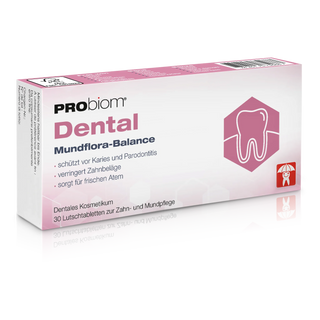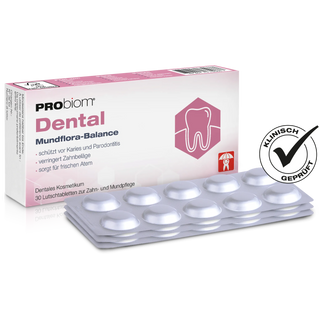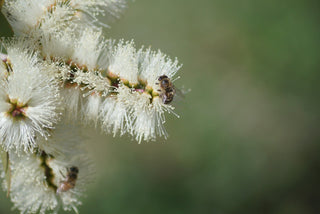When it comes to bacteria in the mouth, many people immediately think of tooth decay, bad breath, or gingivitis. The conclusion seems logical: bacteria are bad and should be eliminated as best as possible. But this view is too simplistic. In fact, our mouth is a complex ecosystem consisting of over 700 different species of bacteria. And many of them are not only harmless but even beneficial. In this article, you'll learn why not all bacteria in the mouth are bad, what functions they perform, and how you can maintain the balance of your oral flora.
The mouth as a habitat: The oral microbiome
Our mouth is a kind of "biological biotope." It is home to a vast diversity of microorganisms, including bacteria, viruses, fungi, and archaea. This ecosystem is called the oral microbiome. The microorganisms settle on the tongue, gums, palate, teeth, and in saliva. They interact with each other and with the host—that is, us.
A healthy oral microbiome is in balance. The various microorganisms keep each other in check, protect against pathogenic germs, and even support our immune system. If this balance is disturbed, for example through poor oral hygiene, a high-sugar diet, or constant disinfection, pathogenic bacteria can multiply and cause problems.
Good vs. bad bacteria: Who does what?
Bacteria cannot be categorized as "good" or "bad." Their effect depends on the context: One and the same germ can be beneficial or harmful depending on the number of other bacteria present, the diet, and the functioning of the immune system. Nevertheless, there are typical representatives that are classified as either beneficial to health or harmful to disease.
Overview: Good and harmful bacteria in the mouth
| category | Typical bacterial species | Effect |
|---|---|---|
| Health-promoting | Streptococcus salivarius, Veillonella spp. | Inhibit inflammation, stabilize pH |
| Neutral | Some Corynebacteria, Actinomyces spp. | Part of the normal oral flora |
| Potentially harmful | Streptococcus mutans, Porphyromonas gingivalis | Promote caries, periodontitis |
Streptococcus salivarius, in particular , is considered a "friendly" bacterium. It helps eliminate pathogenic germs by producing antimicrobial substances. Veillonella, in turn, utilizes lactic acid produced by other bacteria, thus reducing the risk of tooth decay.
In contrast, there are bacteria like Streptococcus mutans , which convert sugar into acids and thus attack tooth enamel. Or Porphyromonas gingivalis , which is associated with gum disease and systemic inflammation.
The functions of the good bacteria in the mouth
Healthy bacteria play an important role in oral health. They not only help control harmful germs but also perform other important functions:
-
Stabilization of the pH value: Many beneficial bacteria counteract the acidification of the oral cavity.
-
Protection against invaders: They compete with pathogenic microorganisms for space and nutrients.
-
Immunomodulation: The microbiome trains the immune system and helps avoid excessive reactions.
-
Pre-digestion: Enzymes from saliva bacteria begin breaking down food in the mouth.
Without this protective function, we would be more susceptible to infections, inflammation and even systemic diseases such as cardiovascular problems.
How does an imbalance in the oral flora occur?
The balance in the mouth can be disturbed by numerous factors, including:
-
An unbalanced diet, especially high sugar consumption
-
Poor or excessive oral hygiene
-
Antibiotic therapies
-
Chronic stress
-
Smoking and alcohol
-
Dry mouth due to medication or respiratory problems
Such influences can cause pathogenic germs to spread, inflammation to develop and the risk of diseases such as caries, gingivitis or periodontitis to increase.
How to strengthen the microbiome in the mouth
The good news: You can do a lot to support your oral microbiome. This includes not only brushing your teeth regularly, but also a conscious lifestyle. Here are some recommendations:
-
Gentle dental care instead of aggressive disinfection
-
Reduce sugar and prefer fiber-rich foods
-
Fermented foods also promote oral flora
-
Probiotic lozenges or mouthwashes with selected bacterial strains
-
Regular dental check-ups to detect problems early
Chewing sugar-free gum can also be helpful because it stimulates saliva flow – a natural protective mechanism against harmful germs.
Conclusion: Not all bacteria in the mouth are bad
The blanket demonization of bacteria in the mouth is not only wrong, but can be counterproductive. Rather, it's the balance of the oral microbiome that matters. The right bacteria in the right combination contribute significantly to oral health and protect against disease.
Instead of fighting all germs, we should learn to live in harmony with them. A balanced diet, conscious dental care, and the targeted use of probiotics can help promote the good bacteria in the mouth and keep the bad ones in check. Because not all bacteria are our enemies—many are valuable allies for our health.













